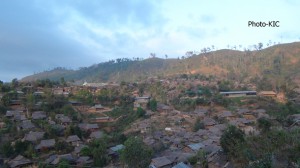Media reports this week that talks between the Burma and the Thai governments focused on repatriation of refugees sent fear and rumours through the nine refugee camps on the border between the two countries.
Reports in the Thai English language media got it wrong, according to a spokesperson for the Committee of Internally Displaced People (CIDKP).
 Saw Steve, chairperson of the Committee for Internally Displaced Karen People spoke to Karen News about the media reports that said: “The government and the Karen National Union have jointly set up a new town project to create job opportunities and resettlement in Myanmar for refugees currently living in Thailand. The new town is built on 750 acres of land located near Malwakhee Village. The project is named Laykaykaw Town and contains industries for job creation. Also, the new town project contains governmental offices, schools, hospital, playground, market, swimming pool, and electricity."
Saw Steve, chairperson of the Committee for Internally Displaced Karen People spoke to Karen News about the media reports that said: “The government and the Karen National Union have jointly set up a new town project to create job opportunities and resettlement in Myanmar for refugees currently living in Thailand. The new town is built on 750 acres of land located near Malwakhee Village. The project is named Laykaykaw Town and contains industries for job creation. Also, the new town project contains governmental offices, schools, hospital, playground, market, swimming pool, and electricity."
Saw Steve said: “The news reports about Lay Kay Kaw Town are not correct. As far as I know the Lay Kay Kaw project is intended only for Palu villagers who were displaced about 25-years-ago after the Burma Army occupied Palu village.”
He said that after the Burma Army offensive “villagers from Palu were scattered to many places, some went into Thailand and some went into refugee camps.”
He explained that after the 2012 preliminary ceasefire agreement between the government and the Karen National Union: “The situation became a little more stable and the Palu villagers wanted to come back to their land, but their land was occupied by outsiders.”
Because of the land disputes the situation was complicated and would take time to solve. So, in the meantime, according to Saw Steve, the “KNU authority had talked to the Palu villagers and looked for a place to resettle them – Lay Kay Kaw was nominated as the resettlement place.”
He also told Karen News that the issue of the resettlement of displaced people was on the KNU’s agenda for discussion with the Burma government.
He said: “Resettlement of displaced people is related to the current peace process and the KNU authority has discussed with the relevant Burma government authorities. In response to this the government visited the Law Kay Kaw area.”
He also believes that it is important that media outlets take the time to make sure their stories are accurate. “I would like to make clear that the Lay Kay Kaw project has not been built as a refugee town nor is it for refugees living in the refugee camps in Thailand to return to or resettle to,” he reiterated.
He again stressed that: “Lay Kay Kaw is intended for the resettlement of the Palu villagers who were displaced many decades ago. However, the site is not limited only to the Palu villagers, if the area has more capacity for settlement, then other displaced people can come and settle. But the first priority is the Palu villagers.”



